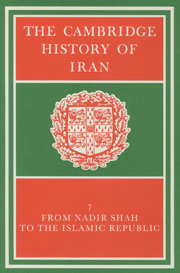Book contents
- Frontmatter
- PART 1 THE POLITICAL FRAMEWORK, 1722–1979
- 1 NĀDIR SHĀH AND THE AFSHARID LEGACY
- 2 THE ZAND DYNASTY
- 3 ĀGHĀ MUHAMMAD KHĀN AND THE ESTABLISHMENT OF THE QĀJĀR DYNASTY
- 4 IRAN DURING THE REIGNS OF FATH ‘Alī SHāH AND MUHAMMAD SHāH
- 5 IRAN UNDER THE LATER QĀJĀRS, 1848–1922
- 6 THE PAHLAVĪ AUTOCRACY: RIŻĀ SHĀH, 1921–41
- 7 THE PAHLAVĪ AUTOCRACY: MUHAMMAD RIŻĀ SHĀH, 1941–1979
- PART 2 FOREIGN RELATIONS
- PART 3 ECONOMIC AND SOCIAL DEVELOPMENTS
- PART 4 RELIGIOUS AND CULTURAL LIFE, 1721–1979
- Genealogical tables
- Bibliographies
- Index
- References
7 - THE PAHLAVĪ AUTOCRACY: MUHAMMAD RIŻĀ SHĀH, 1941–1979
from PART 1 - THE POLITICAL FRAMEWORK, 1722–1979
Published online by Cambridge University Press: 28 March 2008
- Frontmatter
- PART 1 THE POLITICAL FRAMEWORK, 1722–1979
- 1 NĀDIR SHĀH AND THE AFSHARID LEGACY
- 2 THE ZAND DYNASTY
- 3 ĀGHĀ MUHAMMAD KHĀN AND THE ESTABLISHMENT OF THE QĀJĀR DYNASTY
- 4 IRAN DURING THE REIGNS OF FATH ‘Alī SHāH AND MUHAMMAD SHāH
- 5 IRAN UNDER THE LATER QĀJĀRS, 1848–1922
- 6 THE PAHLAVĪ AUTOCRACY: RIŻĀ SHĀH, 1921–41
- 7 THE PAHLAVĪ AUTOCRACY: MUHAMMAD RIŻĀ SHĀH, 1941–1979
- PART 2 FOREIGN RELATIONS
- PART 3 ECONOMIC AND SOCIAL DEVELOPMENTS
- PART 4 RELIGIOUS AND CULTURAL LIFE, 1721–1979
- Genealogical tables
- Bibliographies
- Index
- References
Summary
THE ASCENDANCY OF QAVĀM AL-SALTANA, 1941–7
In Iran, as 1941 ended, the fact that it was an occupied country was more important than the departure of the former ruler and the accession of his twenty-two-year-old son. British and Soviet military units maintained order in the major urban centres and ensured that the communications system contributed to helping the war effort. None of the three allies had any immediate interest in the country itself. Their concern was primarily strategic: to keep the Germans out, ensure the flow of oil, and assist the Soviets with war-materials transported across Iran's mountains and deserts by rail and road. In these circumstances, Iranian politicians found themselves relatively free to pursue their own goals, constrained only by the Allies' preoccupation with internal security. Although public opinion took it for granted that the fate of the country depended once again upon the whims of the British and Russian ambassadors, reviving memories of conditions under the last Qājārs, the reality was rather different. Iran was beginning a decade in which Constitutionalism, accompanied by factional strife, could enjoy free play. The power struggles now being played out were, once again, the politics of élite politicians, landowners or wealthy entrepreneurs for the most part, or their agents; but what was important was that parliament mattered again, as did the office of prime minister. Parties as significant entities did not exist; party slogans and party groupings did. Perhaps a more accurate measure of the resuscitation of political life, febrile though it often appeared to be, was the flowering of a press now comparatively uncensored.
- Type
- Chapter
- Information
- The Cambridge History of Iran , pp. 244 - 294Publisher: Cambridge University PressPrint publication year: 1991
References
- 3
- Cited by



